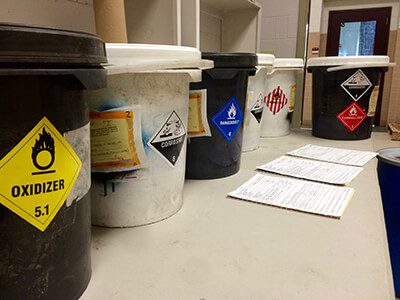
Laboratories will always inevitably produce hazardous waste, which, if improperly managed, can lead to safety issues, damage to the environment, or even catastrophic accidents. By reducing the amount of waste generated and altering how it’s managed, you can prevent health and safety risks and improve the efficiency of your system. There are several ways to improve your output with laboratory waste management – keep reading to learn our best tips.
Types of Laboratory Waste
There are several types of hazardous waste generated by laboratories, most commonly chemical waste and biohazardous waste.
Chemical waste is considered any waste byproduct with chemical agents. This type of waste could include batteries, used oil, spent solvents, or items containing mercury.
Biohazardous waste, also commonly known as medical, biomedical, or infectious waste, is a byproduct of treating diseases in humans or animals. This type of waste could include sharps, pathological or anatomical waste, or blood.
Tips for Laboratory Waste Management
Managing laboratory waste doesn’t have to be time-consuming or complex, but it should be consistent with best practices and regulations. Even the most minor changes in procedure can greatly impact the amount of waste generated from your laboratory.
Here are some suggestions to help manage hazardous waste output:
- Keep inventories up to date with thorough record-keeping.
- Make substitutions for chemicals whenever possible.
- Try to avoid purchasing chemical materials in bulk quantities
- Recycle as many agents as possible – some common examples of laboratory materials that can be distilled, filtered, or recycled include xylene, formalin, and ethyl alcohol.
- Reduce the size and number of the containers you’re using (if you find that you aren’t regularly filling them).
- Manage all chemicals as if they were hazardous to ensure there is no possibility of contamination.
- Make sure you are storing all hazardous waste in the appropriate storage containers.
- Confirm that each container holding hazardous laboratory waste is appropriately labeled with the correct details for what’s inside.
- Regularly train employees in safety procedures for adding waste to and removing from storage containers.
Working With a Reputable Waste Management Company
When choosing a waste management and disposal company, make sure that you select a vendor with the experience to handle the specific waste your laboratory generates. Hazardous and non-hazardous waste can range from facility to facility, so a trusted company significantly within the industry is invaluable. Since you are the one that will have to face any legal issues or fees if waste management is not up to regulatory standards, this is not a decision that should be made lightly. They will help guide you through the management, disposal, or lab relocation process and ensure that you stay within regulations as imposed by the Resource Conservation and Recovery Act (RCRA).
MLI Environmental is one of the most trusted hazardous waste management companies in the region, providing hazardous waste disposal and management services and specializing in dangerous goods shipping. To inquire about our services for your business, please request a quote from our team today!
